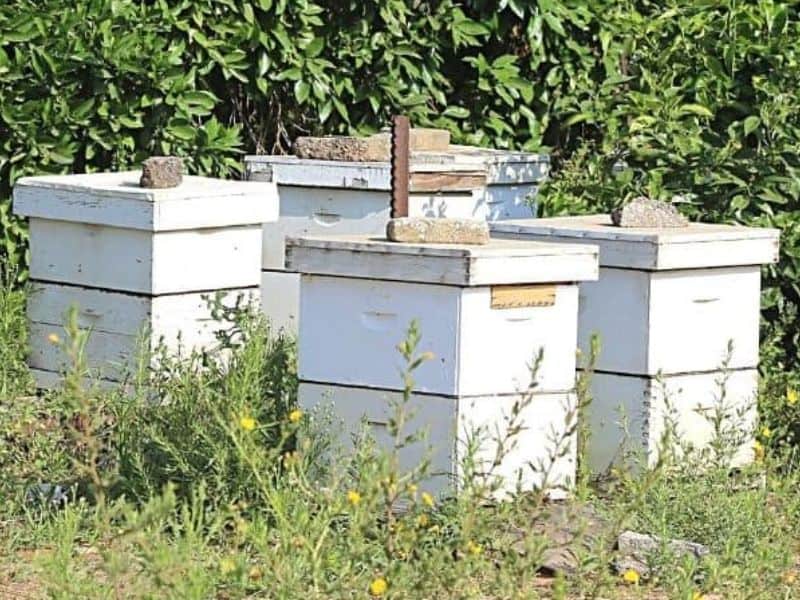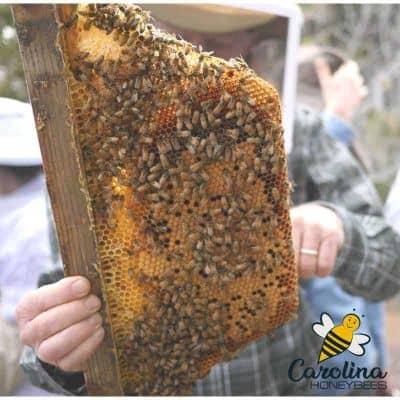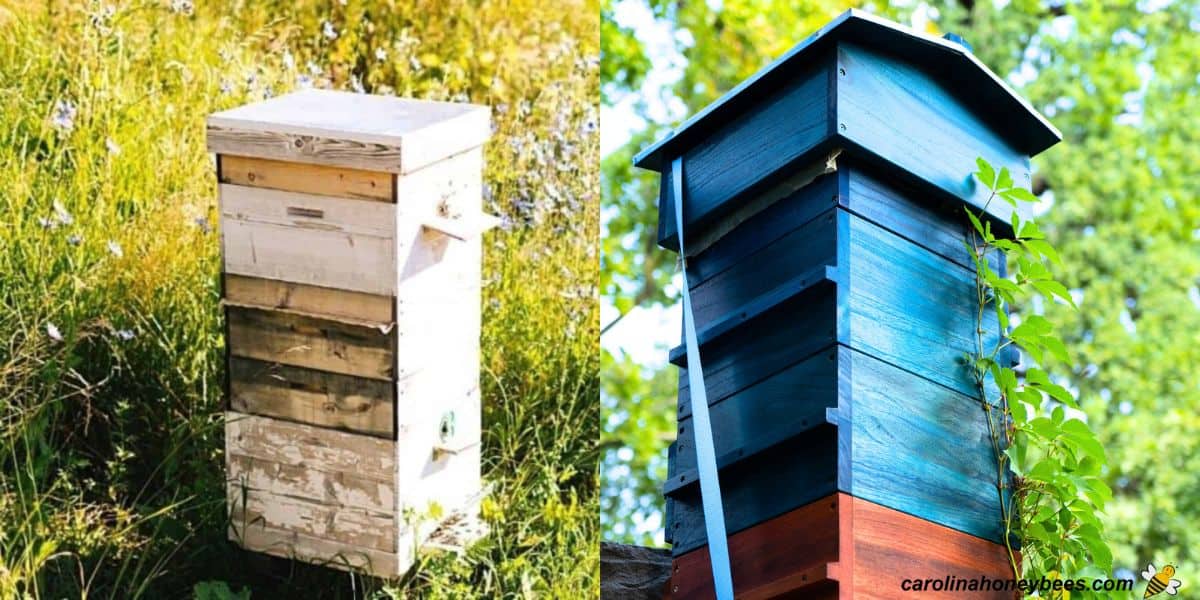Common Types of Beehives
Beekeeping is a practice that has evolved over thousands of years. Yes, even the types of beehives used to keep honey bees has changed over and over. Each beehive has its own advantages and challenges. Understanding which type of beehive is best for your management style is important for your success. Here, I share with you some of the most popular beehive designs in use in the United States today. You can be successful with any of them.

The term “beehive” is most often used to describe a man-made box designed to hold a colony of honey bees. It provides protection from the elements and predators – this is where they build their nest. The beekeeper who understands the pros and cons of each hive style is better equipped to manage their colonies.
Comparing Different Beehive Designs
As we compare the many different styles of beehives used throughout history, we simply must give a nod to the iconic straw skeps.
They were used in Europe and are still in use in some parts of the world today. Beekeepers in remote regions had to use the raw materials they have on hand.

While honey bees all share similar characteristics, people keep colonies for different reasons. You must consider the management needs of your chosen hive. Some require more attention than others.
If you want to produce honey, you may want a design that allows for easy harvest. You should choose a hive style that allows for expansion to give the colony plenty of room.
If pollination of a garden or orchard is your goal, you will not need a beehive with the largest capacity. In fact, some beekeepers do not want to harvest honey at all.
Regardless of the style used in your apiary, educate yourself about the various parts of your equipment and know how they function.
Most Popular Beehive Styles
In the United States, the majority of beekeepers use one of 4 types of beehives. Each has advantages and challenges – as does any box with a colony of bees.
- Langstroth
- Top-Bar
- Warre Hive
- Flow Hive
Storing beekeeping equipment and sharing resources among the colonies in the apiary is easier when everything is the same size. But, some beekeepers try several kinds before choosing a favorite.
Langstroth Beehive
The Langstroth hive is the industry standard and most popular. It was developed in the mid 1800’s by Rev. Lorenzo Langstroth.
His design using removable vertical hanging frames revolutionized beekeeping. Build to specifications using the concept of proper bee space – they made it possible to inspect a beehive without having to cut out and destroy honeycomb.

Langstroth hives (also called “Langs”) consist of boxes stacked one on top of another. The hive begins as 1 or 2 boxes and more super boxes are added as the colony grows.
Wooden frames hang vertically inside the boxes and are usually filled with wax foundation (or plastic) to encourage bees to build comb inside the frames.
The most common size of Langstroth holds 10 frames. Though 8 frame Langs have become more popular in recent years due to ease of lifting.
Advantages:
- most Langstroth parts are interchangeable even if from different manufacturers
- the most common type in use
- a favorite for honey production
- supplies easy to find
- support from other like-minded beekeepers easily available
Challenges:
- Requires storage space for hive components not in use
- Heavy lifting is required
- Bees are building on beeswax foundation with larger cell size than wild bees
- If you choose 8 frame Langs – they are not standard and a bit harder to find.
What is Bee Space?
Since the Langstroth hive is designed on the concept of bee space. Let’s define it. Bee space is a term used to describe a space in the hive of ¼” to 3/8”.
Honey bees use this “gap size” to navigate within the hive (between frames – along the tops of frames and around the outer frames).
Any space smaller than ¼” bees tend to fill with gummy raw bee propolis. Any gaps larger than 3/8” -bees fill with bridge or burr comb. Langstroth’s hive design helped reduce unwanted comb.
Top-Bar Hive
The Top-Bar Hive (also called the Kenyan Top Bar Hive) has a large following in the United States. Originating in parts of the world where they were cheaply made from materials on hand, they are not inexpensive to make in the US.
You will often see the abbreviation “TBH” referring to a top-bar hive. This design is very different from the other styles.

It consists of one long box instead of the stacked boxes of the Langstroth or Warré hives. The horizontal top-bar hive is often considered physically easier to manage.
There are no heavy boxes to move during inspection. The long box is set at a good height reducing back strain when inspecting the individual frames.

Under the roof of this hive, you do not see frames or foundation. Instead, simple top bars of wood (sometimes with a bit of beeswax starter strip) are laid across the box.
The most common number of top bars inside is 24. Inside, the bees build their own honeycomb down from each bar. Top-Bar Hives often having viewing windows so beekeepers can peak inside.
Advantages:
- bees build their own comb
- easier on the beekeeper’s back
- less disturbance during inspections
Challenges:
- natural comb (foundationless) is soft and prone to break during inspection
- feeding colonies – especially winter feeding can be more difficult
- not as much local support
- can be challenging for new beekeepers
- bees may abscond more frequently
Warré Beehive
The Warré Hive was designed by a French monk-Abbé Émile Warré. It is similar to the box style of the Langstroth design.
Warré’s idea was to mimic the inside of a tree – the natural hive of wild honey bees. The boxes are a bit smaller than standard Langstroth boxes.

On the Warré hive, new boxes are added to the bottom of the super stack not the top! This is based on Warré’s idea that bees naturally build down when housed in a hollow tree.
This type of hive management requires more lifting. The top honey boxes are raised to allow placement of a new box on the bottom of the stack. Warré beekeepers often devise types of lift systems to aid in colony management.
The Warré Hive uses no frames or foundation. Each box contains sturdy wooden slats from which bees build comb.
The top box of this hive is called a quilt box. Shavings and other absorbent materials are added here to absorb excess moisture.
You can also build a quilt box for your Langstroth Hive. This aids in important hive ventilation letting in fresh air and removing heavy air.
Advantages:
- Supposedly requires less inspection time (frames aren’t removed)
- Foundation-less – bees build own natural comb
- Supporters say it is more natural
Challenges:
- Illegal in some states
- Can’t easily inspect due to non-removable bars
- Less common system with limited local support
Flow Hive
The Flow Hive. Well, this hive style certainly caused an uproar in the beekeeping community. It sure got people talking about bees – so I guess that is a good thing.
The selling point of the Flow Hive is the easy honey harvest method. These hives have special frames of plastic comb -designed so you can harvest honey with the turn of a crank.

Unfortunately, the early promos for the Flow Hive made beekeeping seem just a bit too easy. Experienced beekeepers were up in arms over the lack of realism in the advertisements.
They felt that this type of beehive would result in people getting bees who were not serious about caring for them. And, this did happen.
In recent years, the company has done a good job of helping people understand that proper hive management is necessary for a good crop.
Advantages:
- easy to harvest honey
- innovate new design
Challenges:
- very expensive
- may be a long wait time for delivery
- doesn’t always work smoothly
Other Styles of Hives
A few other hive designs deserve a quick mention due to their popularity.
Apimaye Hive
The Apimaye Hive is gaining in popularity in the United States. Made from food-grade, UV resistant plastic, this insulated Langstroth style beehive is designed for bees living in extreme climates.
The hive does not absorb moisture and helps colonies survive bitter cold. If you live in a region with very cold Winters, you may consider giving the Apimaye Hive a try.
Horizontal Beehives – Including Layens
Beyond the horizontal top bar, a long horizontal Langstroth hive is favored by some beekeepers. This is especially beneficial to those unable to life heavy boxes.
Another slightly different type of horizontal hive is the Layens Hive. It works on the same idea but has larger frames than a long Lang.
WBC Hive “Classic Hive”

A popular hive style used in the UK is the WBC Classic Hive developed by William Broughton Carr. It is a double-walled structure that provides extra insulation for the cold climates and damp conditions.
The outside wall surrounds separate loose boxes. This makes it difficult to move when full of bees. However, it is a beautiful hive and you will often see it depicted in old paintings and illustrations.
FAQs
Most experts agree that a 10 frame Langstroth hive is best suited for beginner beekeepers and hobbyists. This is due to the fact that the popularity of this kind of hive makes it easy to acquire components.
Some beekeepers feel that top bar hives (and others where bees draw their own comb) is the more natural approach to beekeeping. Unfortunately, we cannot ask the bees – who seem to equally prosper and sometimes die in each style
Beekeepers who only want bees for pollination tend to favor Top-Bar Hives. Beekeepers interested in honey production tend to choose the Langstroth Hive.
Final Thoughts
Whether you build your own beehive or purchase one ready to use, learn the basics of beehive management with common equipment first. The way in which the beekeeper cares for the colony is likely more important than the style of their home. You can be a good or horrible beekeeping with regardless of the hive style.
And if you really want a special experience, you may even decide to buy or build an observation hive and take your bees on the road someday!

